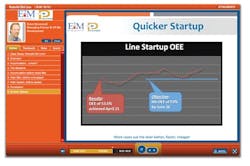By using emulation to test your new controls system off site, you can get your new line up and running at capacity with less time, money and effort. Here’s how one company achieved such results with a highly complex installation.
This company is a global leader in the consumer products industry. At one of its large plants in the southeastern United States, managers needed to add a line that would lead to a new high-speed palletizer. The system involved a maze of conveyors four miles long that would need to be overhauled with 11 new tie-in points.
In addition to multiple decision points, the new solution needed to integrate with some systems that were three years old and others that were nearly 30 years old. This new system would require the addition of four new programmable logic controllers (PLCs), plus modifications to three existing PLCs.
Furthermore, the plant managers were under pressure to get the line up to capacity as soon as possible. The company already had demand for everything they could make, so until the new line could reach capacity, the company was missing an opportunity to generate revenue.
Emulation tools provide solutions
Our engineers tackled that project by designing, programming and debugging the new control system off site, using emulation tools. The controls engineers tested the code in-house on the emulation model, made adjustments, and conducted a final factory acceptance test with the customer using the emulation model. Emulation significantly shortened the time needed to test the system.
Without emulation, controls engineers must wait for the construction of systems before they can check their PLC code, because traditional field testing requires a system be installed and powered up before beginning the test process. Another option is code simulation, which is simply more code in the PLC that is used to tell the real code that it is working. Unlike emulation, however, code simulation doesn’t validate that the PLC code is ready to handle the dynamics of an operating system, nor does it test running scenarios.
Emulation—which involves a PLC controlling a model of the real system—dynamically checks the PLC code before installation. Emulation is effective because it requires the control system to operate a computer model of the installed system in real time, as if it were running the new system on the plant floor.
CASE STUDY Webinar: Click here to view E2M Polytron's resource library at www.polytron.com and see the case study titled, "Rebuilding an Old Beverage Line."
Running a computer model of the system is more powerful than running the system itself in the field, because it can address more variables and yield more useful data in a shorter amount of time. Emulation also gives the engineer the ability to run different scenarios without impacting real production. A manufacturer can, for example, test a new bottle size or package format and find out how the line will operate, without losing production time on the running line. Emulation also makes it possible to test forecasted production on the finished goods handling system.
In the case of the consumer products manufacturer, the PLC code was 95 percent debugged by the time our engineers went on site. The emulation model also was used to train staff on how to run and maintain the working system. The end result was this customer now insists that he would “never do another project without it.”
Brent Stromwall, PE, PMP, [email protected], is vice president of marketing at Polytron Inc (www.polytron.com). Duluth, Ga., a system integrator and a member of the Control System Integrators Association, CSIA (www.controlsys.org).
Subscribe to Automation World's RSS Feeds for Columns & DepartmentsAbout the Author
Brent Stromwall
Polytron Inc.

Leaders relevant to this article:
